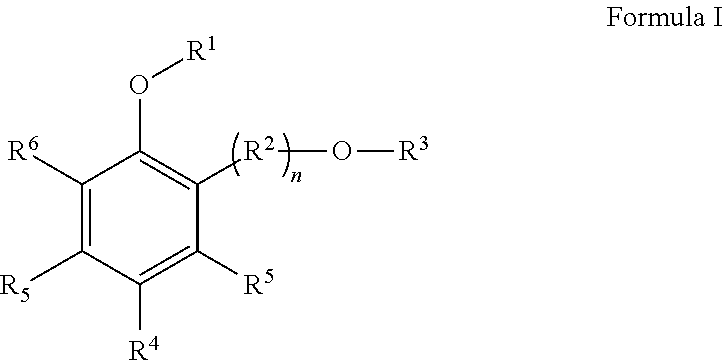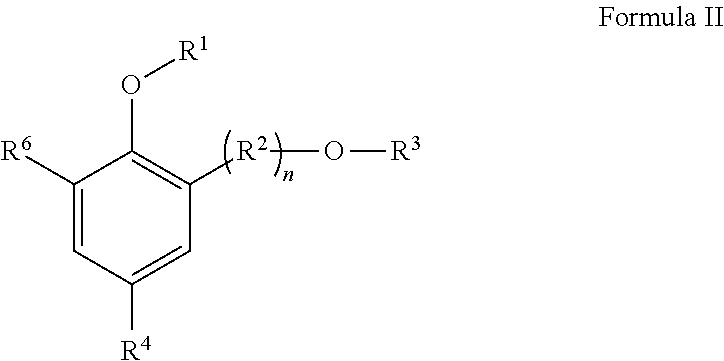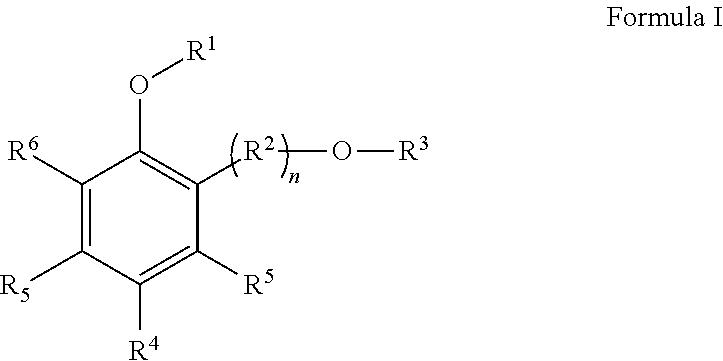Nitrogen Free Deposit Control Fuel Additives
a technology of nitrogen free deposit and fuel additives, which is applied in the direction of fuels, organic chemistry, chemistry apparatus and processes, etc., can solve the problems of increasing engine emissions, reducing the maximum power of the engine, and reducing fuel economy, so as to achieve good performance of fuel detergent additives and improve performance. , the effect of improving performan
- Summary
- Abstract
- Description
- Claims
- Application Information
AI Technical Summary
Benefits of technology
Problems solved by technology
Method used
Image
Examples
example 1
[0081]A nitrogen-free fuel additive is prepared by mixing 1000 grams of mid vinylidene 1000 Mn Polyisobutylene (TPC 1105™ available from the Texas Petrochemicals LP) with 217 grams of toluene. The mixture is then charged to a reaction vessel. To the reaction vessel 281.2 grams of ortho cresol and 122 grams of toluene are charged, and the system is stirred for 15 minutes under a nitrogen blanket. Over 3 hours, 19.9 grams of boron-trifluoride etherate is added to the reaction vessel in a dropwise manner while the mixture in the reaction vessel is stirred and kept below 25° C. After the addition is complete, the mixture in the reaction vessel is stirred for 3 hours at ambient temperature. Then 41.5 grams of lime and 41.5 grams of Fax-5 filter aid is then added to the reaction vessel, which is then allowed to stir overnight. The reaction mixture is then filtered using a sinter glass filter funnel and a Fax-5 filtering pad. After filtration the filtrate is charged to a vessel and vacuum ...
example 2
[0082]A nitrogen-free fuel additive is prepared by mixing 165 grams of PiB cresol, derived from mid vinylidene 1000 Mn Polyisobutylene (TPC 1105™ available from the Texas Petrochemicals LP) and toluene (as described in the first part of Example 1 above), and 47.8 grams of methanol and 6.8 grams of paraformaldehyde in a reaction vessel. The reaction mixture is then stirred and heated to 55° C. under a nitrogen blanket. Then 32.4 grams of a mixture of sodium methoxide at 25% actives in methanol is added to the reaction vessel subsurface over 70 minutes. After the charge is complete, the reaction mixture is heated to 60° C. and then held at temperature for 150 minutes. The reaction mixture is then cooled back to ambient temperature and then transferred to a rotary evaporator. The material is vacuum stripped at 0.7 bar and 105° C. to remove the methanol. The product is then cooled and collected. The collected material contains a nitrogen free additive.
example 3
[0083]A nitrogen-free fuel additive is prepared by mixing 250 grams of PiB cresol, derived from mid vinylidene 1000 Mn Polyisobutylene (TPC 1105™ available from the Texas Petrochemicals LP) and toluene (as described in the first part of Example 1 above), and 73.0 grams of methanol and 10.2 grams of paraformaldehyde in a reaction vessel. The reaction mixture is then stirred and heated to 55° C. under a nitrogen blanket. Then 49.7 grams of a mixture of sodium methoxide at 25% actives in methanol is added to the reaction vessel subsurface over 70 minutes. After the charge is complete, the reaction mixture is heated to 60° C. and then held at temperature for 150 minutes. The reaction mixture is then cooled back to ambient temperature and then transferred to a rotary evaporator. The material is vacuum stripped at 0.7 bar and 70° C. to remove the methanol. The product is then cooled and collected. The collected material contains a nitrogen free additive.
[0084]The examples described above ...
PUM
| Property | Measurement | Unit |
|---|---|---|
| polydispersity | aaaaa | aaaaa |
| polydispersity | aaaaa | aaaaa |
| polydispersity | aaaaa | aaaaa |
Abstract
Description
Claims
Application Information
 Login to View More
Login to View More - R&D
- Intellectual Property
- Life Sciences
- Materials
- Tech Scout
- Unparalleled Data Quality
- Higher Quality Content
- 60% Fewer Hallucinations
Browse by: Latest US Patents, China's latest patents, Technical Efficacy Thesaurus, Application Domain, Technology Topic, Popular Technical Reports.
© 2025 PatSnap. All rights reserved.Legal|Privacy policy|Modern Slavery Act Transparency Statement|Sitemap|About US| Contact US: help@patsnap.com



